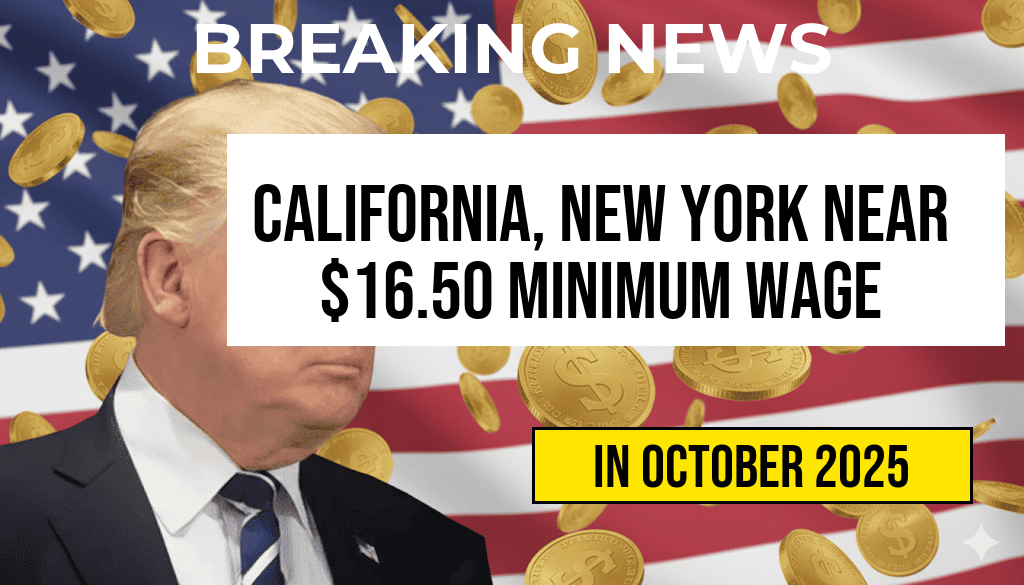California and New York are on the cusp of reaching a significant milestone in their minimum wage policies, with both states approaching a $16.50 per hour threshold. As policymakers and business leaders prepare for potential adjustments, the move reflects broader efforts to address rising living costs and income disparities across major urban centers. This development is poised to impact millions of workers, influence employment dynamics, and reshape a competitive landscape that has long been shaped by regional economic priorities.
Rising Minimum Wages Reflect Regional Economic Pressures
Over the past decade, California and New York have steadily increased their minimum wages, aiming to bolster earnings for low-wage workers amid soaring housing costs and inflationary pressures. Both states set ambitious targets, with legislative measures often tied to inflation adjustments or economic milestones. Currently, California’s minimum wage stands at $15.50 for large employers and is scheduled to reach $16.00 in 2024, while New York’s standard minimum is aligned at $15.00 statewide, with some localities surpassing that figure.
Sources like the Wikipedia entry on U.S. minimum wages detail how states implement incremental increases based on legislative schedules, economic conditions, and political consensus. As both California and New York approach the $16.50 mark, discussions around the implications for workers, businesses, and the economy are intensifying.
Projected Timeline for Reaching the $16.50 Benchmark
| State | Current Minimum Wage | Projected Date for $16.50/hr | Notes |
|---|---|---|---|
| California | $15.50 (2023) | Mid-2024 | Adjustments based on inflation and legislative schedule |
| New York | $15.00 (2023) | Late 2024 to early 2025 | Varies by locality; NYC reaching $16.00 in 2023 |
Sources such as the Forbes article on state wage policies provide insights into how these timelines are shaped by political and economic factors.
Implications for Workers and Employers
Reaching a $16.50 per hour minimum wage could significantly improve income levels for millions of workers in both states. In California, where housing prices and living expenses are among the highest in the country, this increase may help narrow the wage gap for low-income earners. Similarly, New York’s urban centers, including New York City and surrounding suburbs, stand to benefit from higher earnings, potentially reducing reliance on public assistance programs.
However, these wage hikes also raise concerns among business groups and economists. Critics argue that higher labor costs could lead to reduced hiring, increased automation, or shifts in employment to neighboring states with lower wages. Small businesses, in particular, may face challenges in balancing wage increases with their operational budgets, prompting debates about the long-term effects on employment levels and regional competitiveness.
Regional Variations and Local Policies
While both states aim for a uniform $16.50/hr threshold, localities within California and New York often set their own minimum wages that surpass state mandates. For example, California’s localities such as Los Angeles and San Francisco already establish higher minimums, reflecting local housing markets and economic conditions. Similarly, New York City’s minimum wage has been set at $15.00/hr since 2019, with plans to increase to $16.00/hr in 2023, and local efforts continue to push wages higher.
This patchwork of wage policies underscores the importance of regional economic contexts, as businesses must navigate complex compliance landscapes while workers seek fair compensation aligned with local costs of living.
Looking Ahead
As California and New York inch closer to the $16.50/hr barrier, stakeholders from policymakers to labor advocates are closely monitoring the potential economic ripple effects. While the increases are seen as steps toward reducing income inequality, the broader impact depends on how businesses adapt to higher wages and how employment opportunities evolve in high-cost urban centers.
For more detailed information on regional minimum wage policies and their economic implications, sources like the U.S. Bureau of Labor Statistics provide comprehensive data and analysis.
Frequently Asked Questions
What is the new minimum wage threshold being approached in California and New York?
The minimum wage threshold in California and New York is approaching $16.50 per hour, signaling potential changes in labor costs and employee compensation standards in these states.
When is the minimum wage increase expected to take effect?
The increase towards the $16.50 hourly minimum wage is anticipated to be implemented gradually over the upcoming months, with specific dates varying by state and locality.
How will this wage increase impact businesses in California and New York?
The wage increase may lead to higher labor costs for businesses, potentially influencing pricing strategies, employment levels, and operational expenses within these states.
Are there any exemptions or different rates for certain types of workers?
Yes, some exemptions or differing wage rates may apply to specific categories of workers, such as tipped employees or young or seasonal workers, depending on state regulations.
What are the reasons behind the push to increase the minimum wage to $16.50?
The push for raising the minimum wage aims to improve living standards, reduce income inequality, and ensure fair compensation for workers in these high-cost states.






